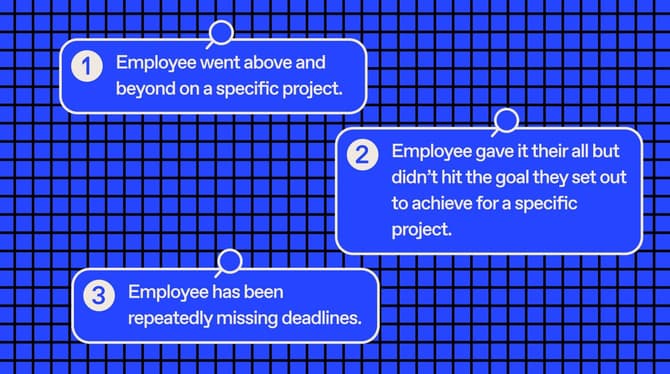Being a manager means juggling people management with a busy agenda and a long to-do list. With so much going on at all times, it can be hard to spot if one of your employees isn't as invested in the team or company anymore.
Learning to spot the signs of disengagement is important because it can take some time to understand the causes and build action plans accordingly. The earlier you detect these signs, the less progressed disengagement will be, which means you'll face fewer obstacles to reverse it.
If you're not sure where to start, this article is for you. Read on to learn how to identify early symptoms of disengaged employees and implement the right next steps to reactivate your employees' engagement.
Exclusive online summit
·
May 23 2024
Moments that matter: how to seed great work
What's in this article
What are employee engagement and disengagement?
Employee engagement is the level of involvement people feel in their jobs, their dedication to the organization, and the amount of effort and energy they put into their direct work.
Engaged employees tend to be happy at work and feel valued by leadership. They work with authentic energy and find more satisfaction in their daily tasks.
Disengaged employees, on the other hand, may not feel like themselves at work. They may feel more stress, and show signs of fatigue, loneliness, sadness, and even anger (and if they are experiencing issues in their personal lives, these feelings may be amplified in the workplace).
9 signs of disengaged employees
Disengaged employees are not just unhappy employees. There are a number of other signs and effects to look out for. And while engagement can fluctuate, we can't assume that a disengaged employee will eventually bounce back on their own. If they don't seem like an active part of the team anymore, you need to keep an active eye out.
Why? Because, as we see time and time again, disengagement often results in:
- People quitting the team and an increase in employee turnover
- Inability to deliver team projects
- Team conflict (between engaged and disengaged employees)
- Mistakes (sometimes minor, sometimes more severe)
- Your time redirected from your to-do's, into addressing all of the above
Addressing unhealthy behaviors like missed deadlines, doing the bare minimum, or leaving early all the time are not just the responsibility of HR professionals. Your impact as a manager matters more than you may think, so you shouldn't wait until it's too late to address disengagement.
75% of employees who display low levels of engagement or leave their jobs say it's due to their manager or leadership.
The state of the employee experience
Our report uncovers some thought-provoking employee disengagement statistics. Read more to find ways to turn things around and support a team of highly engaged employees.
Early signs of employee disengagement
An actively disengaged employee will shift from how they used to be. It's not always a clear sign and doesn't necessarily show up as a negative attitude. Sometimes it manifests as a change in their personal work ethic, work quality, or even level of communication within the workplace.
Some early behaviors you should look out for are:
- A team member who used to love sharing ideas suddenly doesn't do it anymore.
- A team member who used to reach out to other team members now isolates or sticks to their own space.
- A team member who used to be on top of deadlines starts missing some.
- A team member who used to contribute to other aspects of the team (outside of the scope of work) no longer does it.
What's the common denominator? One prominent sign you're looking for here is a change in behavior.
🗒️ Quick note: Keep in mind that it's important to contrast the disengagement symptoms with a previous record of behaviors. Not all employeeshave to innovate all the time, contribute outside their scope of work, go the extra mile, or be a top performer every day.
In an ideal world, sure, that would be nice. But we shouldn't have these expectations from every employee. Sometimes they simply have low energy, have been taking more breaks, or may be going through some personal issues.
Drastic signs of employee disengagement
The longer you let disengagement go undetected, the higher the chances are of it becoming progressively worse. This is neither good for the team and organization, nor for the employee dealing with disengagement.
Some of the most serious signs of a disengaged employee are:
- They start making mistakes (often).
- They don't have answers to questions that correspond to their day-to-day job.
- They often reschedule or cancel meetings with you (their manager) or team meetings and team calls with their peers.
- They openly resist change with a bad attitude.
- They stop following protocol and dynamics.
Whether an employee misses meetings altogether or is behind on deadlines, always take note of these changes. Even if you notice early or more drastic behaviors of disengagement, there's still a lot you can do to retain the talent and help an actively disengaged employee become engaged again.
💡Check out some of our top tips on how to improve employee engagement and retention.
Reasons why employees disengage
Before you can properly tackle engagement issues, it's helpful to understand what caused your employees to disengage. That way, you can nip it in the bud and avoid further problems.
High levels of stress and feeling overwhelmed
Occasional stress is normal in any job, but it can't be a constant. If so, your employees will suffer from burnout and disengagement. In fact, Officevibe Pulse Survey data shows that 39% of employees feel negatively about the levels of stress related to their work and 47% often feel overwhelmed at work, so it's important to recognize the causes.
Our data shows that the top 3 factors affecting stress at work include:
- Workload
- Access to non-material resources (like support, training, and knowledge)
- Pay
If, during your self-reflection and diagnosis, stress and feeling overwhelmed seem to be the issues, talk to your team member about these 3 elements and gather their thoughts.
When noticing a disengaged employee, you'll likely discover signs like a lack of motivation to complete everyday tasks or goals, signs of poor sleep, difficulty focusing during meetings or in their own work time, and isolation from the team or social events. If your employees' work is suffering, it's time to connect.
💡To help guide you through the conversation with your team member, consult our meeting template to discuss work stress.
Lack of professional development
We all want to grow and develop. A key aspect of keeping a job interesting is to feel challenged and know that you're moving forward. Considering 30% of Officevibe users say they don't have the opportunity to grow within their organization and 42% see no clear plan to improve their skills, this is especially important. Knowing where you excel and need to improve is essential to career development.
Our data shows that recognition, feedback, and professional development are mostly affected by frequency and timeliness. Employees need new challenges in order to feel highly engaged. Staying in tune with your team and their professional progression is key to making sure they remain engaged employees over time.
Feedback and recognition
If you want to turn a disengaged employee into an engaged employee, you need to focus on offering this constant development, as well as feedback and recognition. Creating a culture of recognition in the workplace is essential, eventually leading to better engagement.
Did you know that 40% of employees are unhappy with the frequency of recognition they receive, and 30% are unsatisfied with the amount of feedback they get?
Ask your team how often they would like to receive feedback from you, and brainstorm ideas to better recognize them.
Officevibe's employee engagement solution measures employees' satisfaction with the frequency and quality of both feedback and recognition, which can help you identify if either are an issue for your team.
Lack of trust, poor communication, and poor collaboration
Working remotely is challenging these areas more than ever. It's not easy to smoothly translate everything that was in-person into a digital context.
Our data shows that collaboration, communication, and trust are affected by:
- Levels of transparency
- Ability to voice one's opinion
- Manager's time availability
The first step to addressing the lack of trust, communication, and collaboration is to help your team feel heard. Offer a dedicated time and place, like a one-on-one meeting, to openly talk about the things your employees are struggling with. Make sure your team knows they can always reach out, and encourage team members to communicate with each other as well.
If you're looking for a solution to give your team a safe and permanent place to share their opinions, without having to add to your work pile, an anonymous feedback tool is a great solution. They can instantly elaborate on specific pain points, and you can respond to their comments while letting them stay anonymous.
Unfair compensation
If employees don't feel their efforts are being compensated fairly, it will be easy for them to disengage and start looking for other opportunities.
We know that team leaders don't always have the ability to change their team members' compensation. So what can you do?
We suggest taking time to align expectations with your disengaged employees. This can help you fill some gaps, look into any excessive workload, and gather insights for upper management to drive change.
Poor change management
Organizations and company cultures evolve and change, and that's a good thing! But we need to make sure we help our teams adapt to those changes, too.
Officevibe data shows that employee motivation and engagement are strongly correlated to:
- Having the ability to connect with the organization’s values and purpose.
- The leaders’ ability to communicate those values and that purpose.
Take the time to bring up any changes your team and/or organization have gone through. Have these impacted how your unengaged employees perceive the company? Do they still have everything they need to meet their (sometimes new) objectives?
Lack of resources and/or support to meet the organization's objectives
Sometimes, it all boils down to employees feeling that they lack help within their team or organization. Oftentimes, this stems from simply not having the right resources to meet the organization's objectives, despite being expected to do.
35% of employees feel their workplace doesn't invest enough resources to measure up to its ambitions.
Officevibe Pulse Survey data
But how can you find out if your team struggles with this?
Employee engagement surveys help management see if employees are disengaged before it happens – even if they don't have time to connect with their employees face-to-face in the workplace. These surveys can help managers collect valuable information and data about their employees that they may not have known about, and in turn, offer support.
Actionable tips to re-engage disengaged employees
The best way to identify that something's off before it's too late is by having a record of engagement metrics. By tracking engagement metrics, you'll spot early signs and notice a decline as soon as it happens. Officevibe tracks engagement and runs a quick employee engagement survey each week to check in with your people and ask them for feedback.

That means no matter how busy you are, you're still getting information about how your employees feel and what they need. You can check the data and employee feedback from anywhere, at any time, and respond to their concerns as they arise.
The best part? It smoothly integrates into your team's day-to-day. You can focus on your responsibilities as a team leader, while the tool collects and analyzes the data for you.
So let's break down the steps.
1. Run diagnostics and identify what is disengaging your employees
The first step to solving any problem is to figure out what it is. Tools like employee engagement surveys, anonymous feedback, and one-on-one meetings can help you diagnose signs of disengagement. Open communication can help you retain your top performers, get closer to your team, pinpoint strengths, and come up with solutions.
The key is to ask the right questions. And if you're unsure where to start, you can pull from a curated employee engagement survey question bank. From there, you can address each of the common causes of disengagement and explore what you can do.
2. Self-reflect and be empathetic above all
Once you're able to identify what's causing disengagement, the next step is to put yourself in your team's shoes and be empathetic. Try to see things from their perspective and reality.
Ask yourself and self-reflect:
- If I was in their position, how would I react to the situation?
- What negative changes or situations have we recently faced as a team that also affected that person (or people)?
- Have I been proactive in making sure they have everything they need?
- Think about moments when this person (or people) brought value to the team.
- Reflect on the uniqueness of the employee(s) and their work.
3. Immediately, book a one-on-one meeting (and be honest)
Once you self-reflect and try to sympathize with what is causing an employee to disengage, book a one-on-one meeting.
This template can help guide your talking points during your one-on-one:
- Tell them upfront that you have noticed their disengagement (make sure you come from an empathetic point of view and genuine place to help, as opposed to this being a performance review).
- Mention specific changes in behavior you have observed (the clearer the examples, the better!).
- Bring up stories of your self-reflection about the value they bring to their team, and their potential.
- Give them room to tell you what they think (what is causing them to disengage, their perceptions and feelings). And really listen.
- Set action items that show your team member(s) that you're committed to their employee engagement, and help them know what to do next.
If your team members don't mention any subjects that you identified in your diagnoses and/or self-reflection, be proactive in bringing them up!
There's a chance your employee might be able to verbalize why they're disengaged, why they've lost interest in their job, or why they no longer feel motivated, but may not be clear on where their disengagement is coming from.
💡To help you be proactive, we put together some topics to bring up during your one-on-ones, along with the next steps. Use these one-on-one meeting templates as inspiration.
Encouraging engaged employees within your organization
Now that you know what obvious signs and subtle changes to look out for in a disengaged employee, you'll see the bigger picture. This way, you'll be better prepared to take the steps to help them become engaged employees who are part of the company culture once again. When employees are engaged and happy, business thrives, and when employees are disengaged, the whole team and the whole company feel the effects.
Communication is key, and we like to believe that there's no such thing as non-necessary conversations. Officevibe offers the tools you need to help your company establish better communication with everyone.



